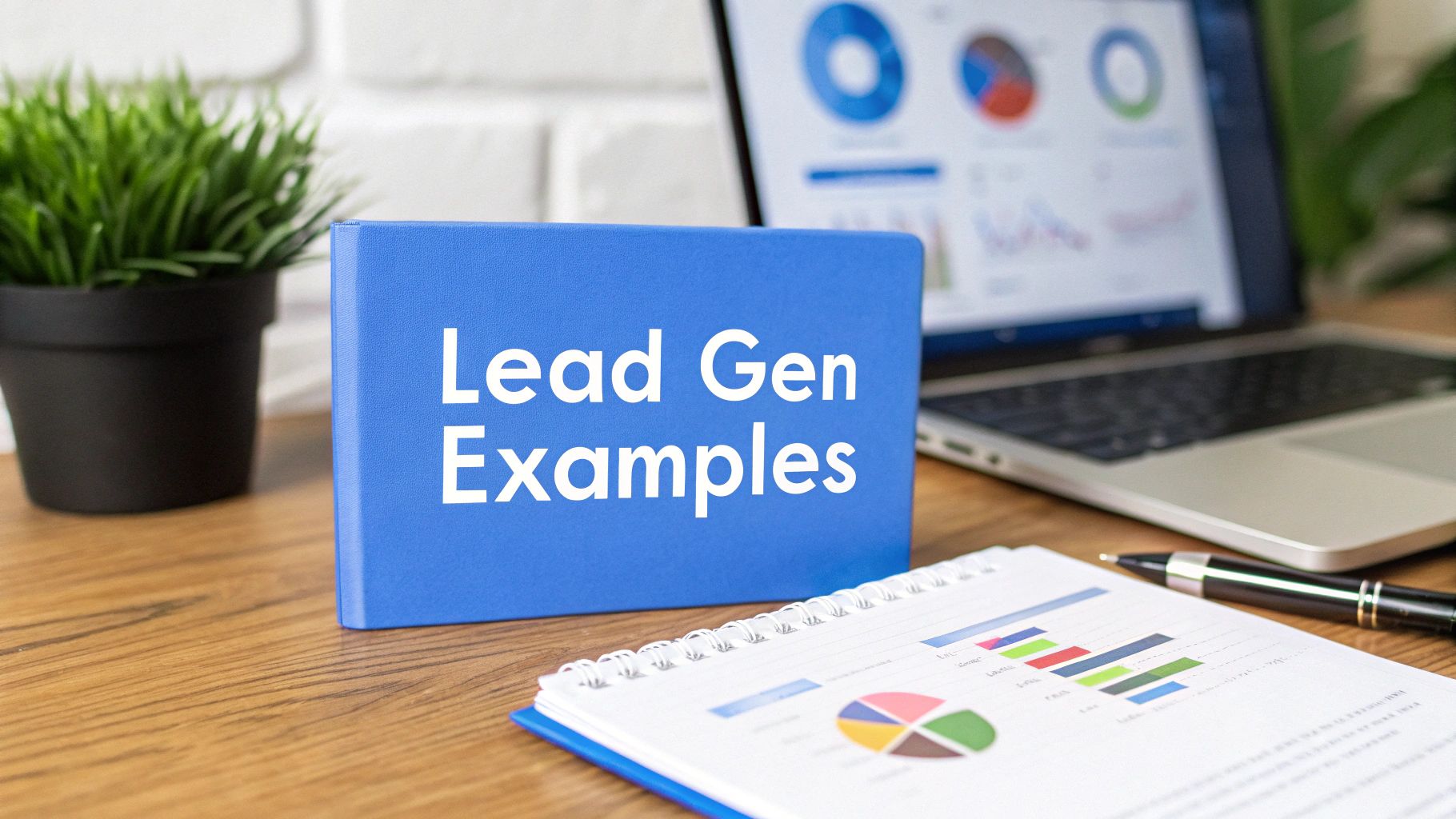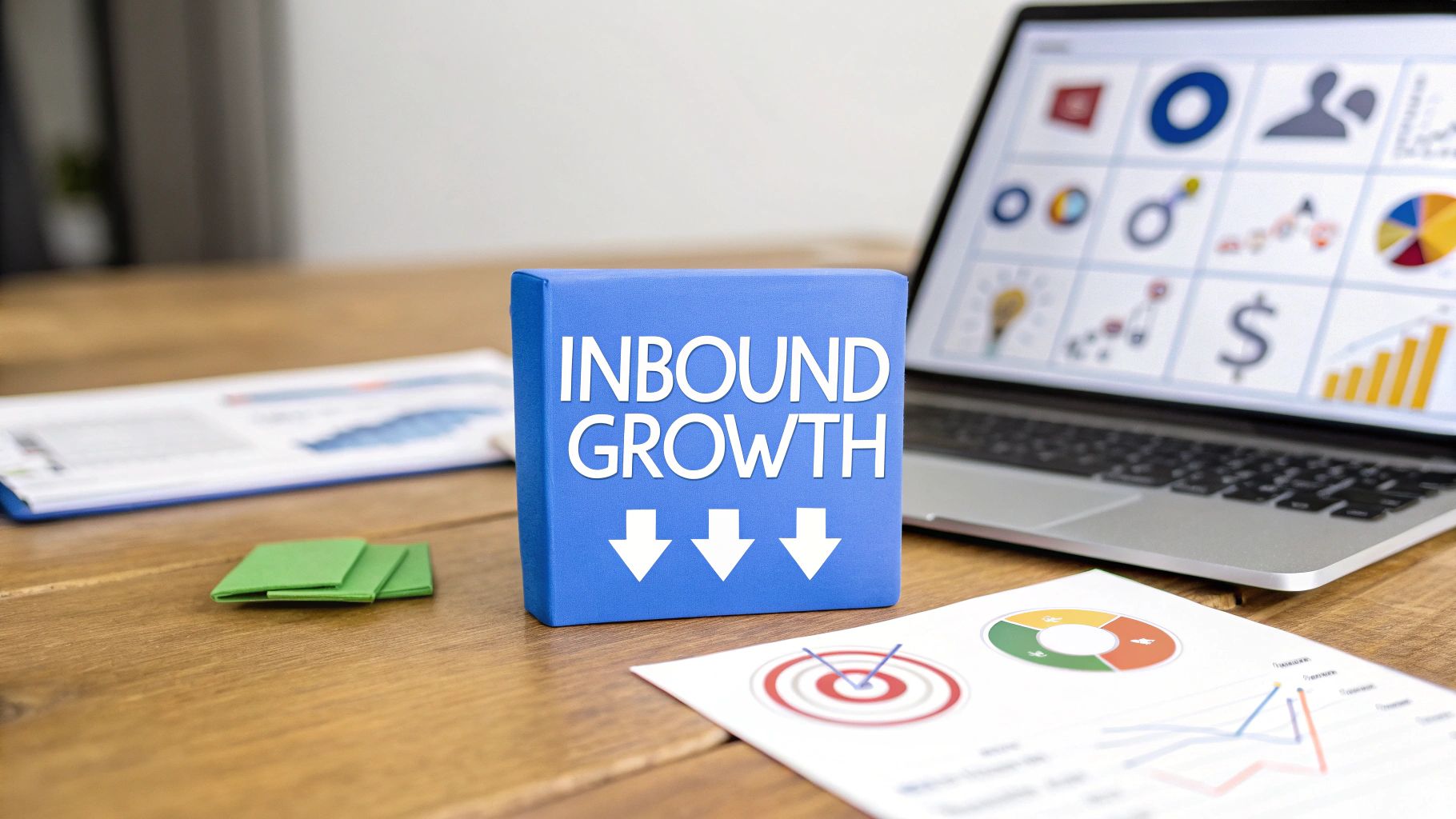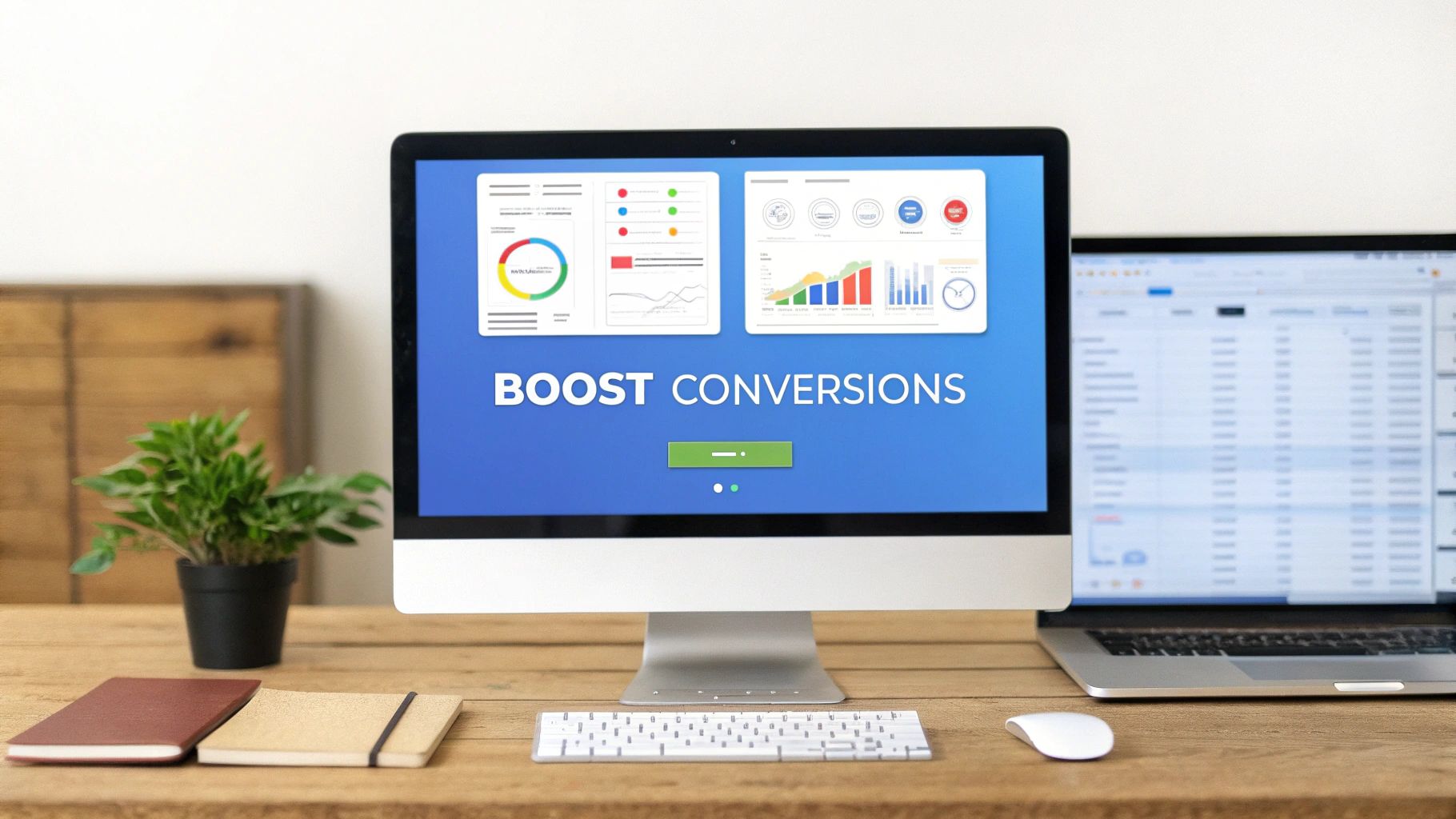Summary
Meta description: Discover top lead gen examples from industry leaders like HubSpot, Salesforce, and Dropbox. Learn actionable strategies to boost your marketing and get more qualified leads.
In the relentless pursuit of business growth, lead generation is the engine that drives everything forward. But are your campaigns capturing the attention of your ideal customers? Many marketers face diminishing returns because they're trying to reinvent the wheel.
The solution? Learn from the best. Studying successful lead gen examples provides a direct blueprint for what works right now.
This guide is your tactical playbook. We’ll dissect real-world campaigns from diverse industries, breaking down how leading brands leverage everything from content funnels and email sequences to social media ads and strategic SEO. Ready to see how they do it?
To truly unlock growth, you need to combine proven frameworks with innovative examples. For deeper insights, explore the most effective lead generation best practices for 2025. Let's deconstruct the mechanics of high-performance marketing and discover replicable strategies to fuel your pipeline.
1. Content Marketing and Lead Magnets
Content marketing is a cornerstone of modern lead generation. It’s all about creating valuable, relevant content to attract and retain a specific audience. When you pair this with a lead magnet, it becomes one of the most effective lead gen examples for capturing high-quality prospects.
What is a lead magnet? It's a high-value resource you offer visitors in exchange for their contact information, like an email address. This could be an eBook, a whitepaper, a checklist, or a template. The principle is simple: you provide expert knowledge that solves a problem, and they grant you permission to market to them.
Strategic Breakdown: How HubSpot Dominates with Lead Magnets
HubSpot has mastered this technique. Instead of just blogging about marketing, they offer a huge library of practical resources like their "Free Business Templates" collection. These are actionable tools that professionals can use immediately.
- Goal: Capture leads from their target audience (marketers, business owners) who are actively seeking solutions.
- Tactic: Offer comprehensive template bundles (e.g., social media content calendar) that solve pressing challenges.
- Landing Page: Each collection has a dedicated landing page with a clear value proposition, bullet points, and a concise form. The focus is entirely on the user's benefit.
- Outcome: This strategy has generated millions of leads, establishing HubSpot as an industry authority and fueling their sales pipeline.
Replicating the Strategy: Actionable Takeaways
How can you make this lead generation example work for you? Focus on specificity and value. Create a resource so useful your audience would pay for it, then offer it for free.
- Identify a Specific Pain Point: What's one major challenge your ideal customer faces? Create a lead magnet that solves it directly.
- Optimize Your Landing Page: Keep the headline benefit-oriented, use visuals, and make the form as short as possible.
- Nurture, Don't Just Sell: Once you have the lead, follow up with an email sequence that provides more value before you pitch your product.
The infographic below highlights key benefits of using content marketing and lead magnets for lead generation.
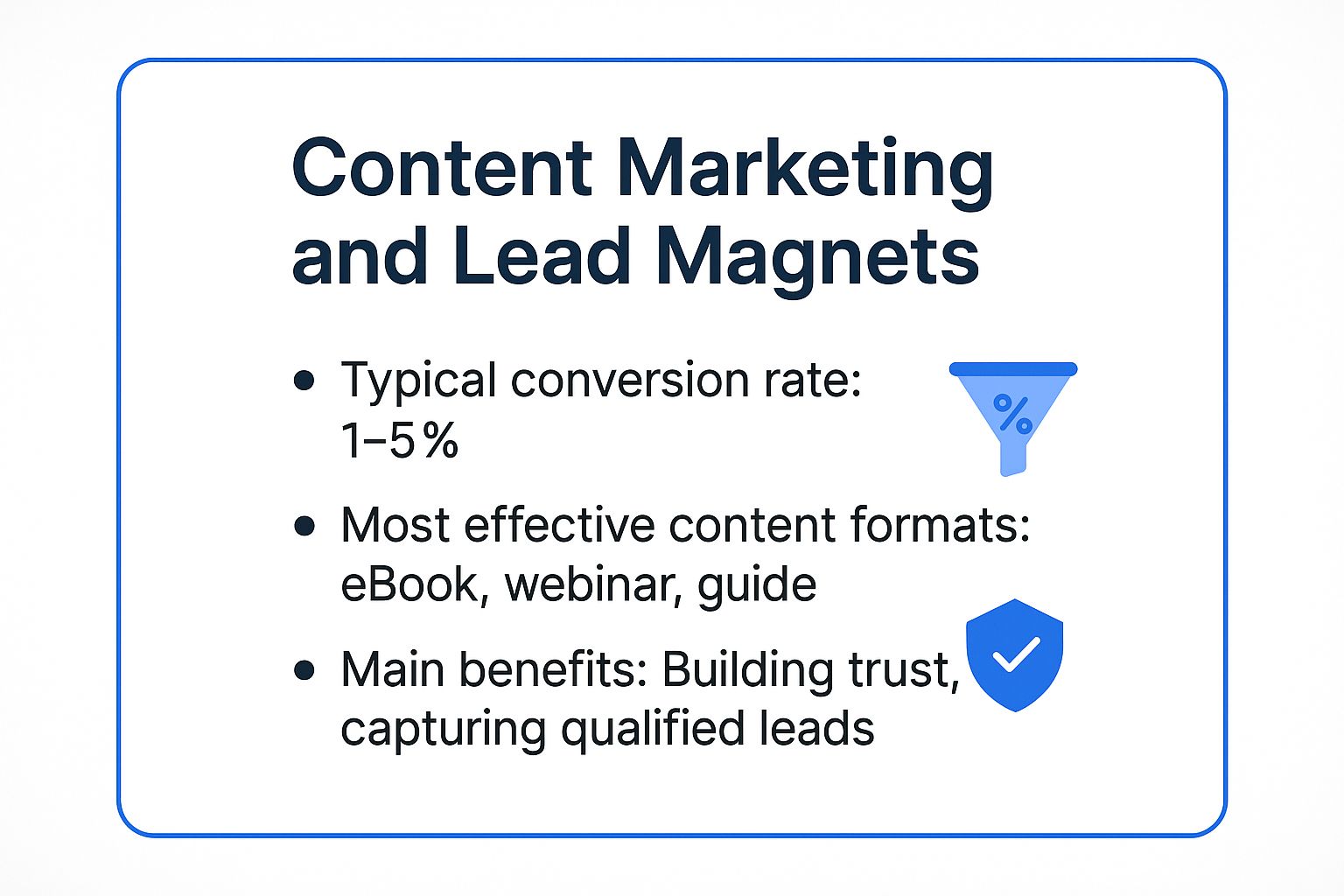
This approach builds trust while consistently capturing leads who have shown genuine interest in your expertise.
2. Social Media Lead Generation
Social media is no longer just for brand awareness; it's a powerful engine for direct lead generation. This strategy involves using platforms like LinkedIn, Facebook, and Instagram to connect with and convert prospects through organic content, targeted ads, and direct engagement.
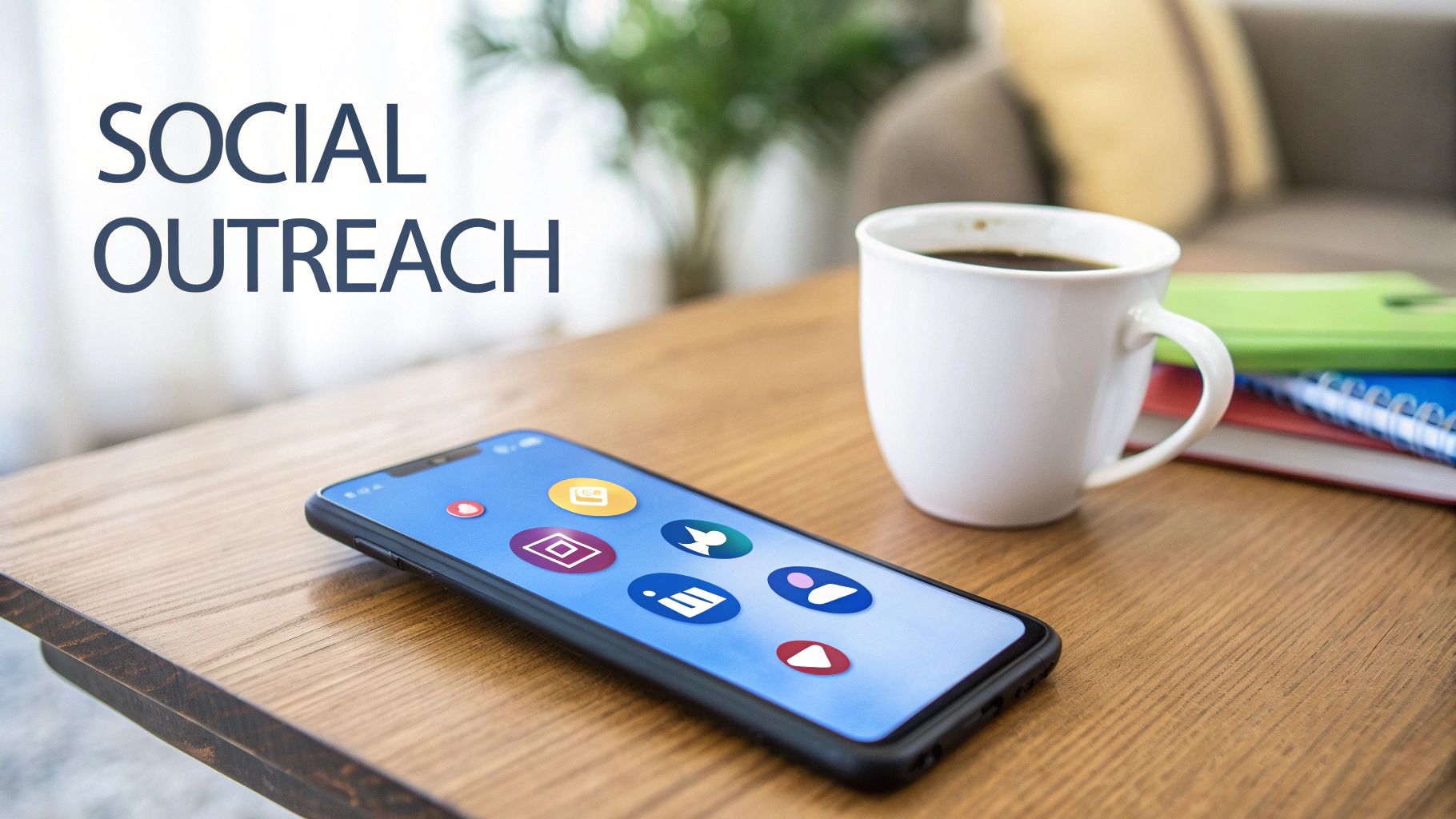
The key is to meet your audience where they already spend their time. Instead of pulling users away, modern social lead gen examples use features like integrated lead forms that pre-populate user data, creating a frictionless experience that boosts conversion rates.
Strategic Breakdown: How LinkedIn Lead Gen Forms Simplify B2B Conversion
LinkedIn is the leader in B2B social media, and its native Lead Gen Forms are a perfect case study. When a user clicks an ad, a form pre-filled with their profile information appears. This removes the friction of manual data entry, dramatically increasing submissions.
- Goal: Capture high-quality B2B leads directly within LinkedIn, minimizing friction and maximizing ROI.
- Tactic: Promote valuable content like whitepapers or webinars using Sponsored Content. Attach a Lead Gen Form that auto-populates the user's details.
- Landing Page: The ad creative and copy act as the landing page. No external page is needed, which keeps users in the app and reduces drop-off.
- Outcome: LinkedIn reports that Lead Gen Forms can decrease cost-per-lead by over 20% and boost conversion rates by up to 3x. This makes it one of the most efficient lead gen examples for B2B marketers.
Replicating the Strategy: Actionable Takeaways
Want to effectively use social media for lead generation? You need to combine platform-native tools with authentic engagement.
- Choose Your Platform Wisely: Focus your efforts where your target audience is most active. B2B thrives on LinkedIn, while e-commerce often sees better results on Instagram or Facebook.
- Leverage Native Features: Use tools like LinkedIn Lead Gen Forms, Facebook Lead Ads, or Instagram's poll stickers. They're designed for a seamless mobile experience.
- Engage Authentically: Don't just broadcast promotions. Participate in conversations, answer questions, and share valuable content to build trust.
3. Email Marketing Campaigns
Email marketing remains one of the most direct and powerful channels for lead generation. It allows you to nurture prospects, build relationships, and guide them through the sales funnel. By using segmented lists and personalized messaging, businesses can convert subscribers into loyal customers.
This method stands out among lead gen examples because it facilitates direct, one-to-one communication at scale. Instead of broadcasting a single message, you can deliver tailored content based on a user's behavior and interests. This personalization is key to its effectiveness.
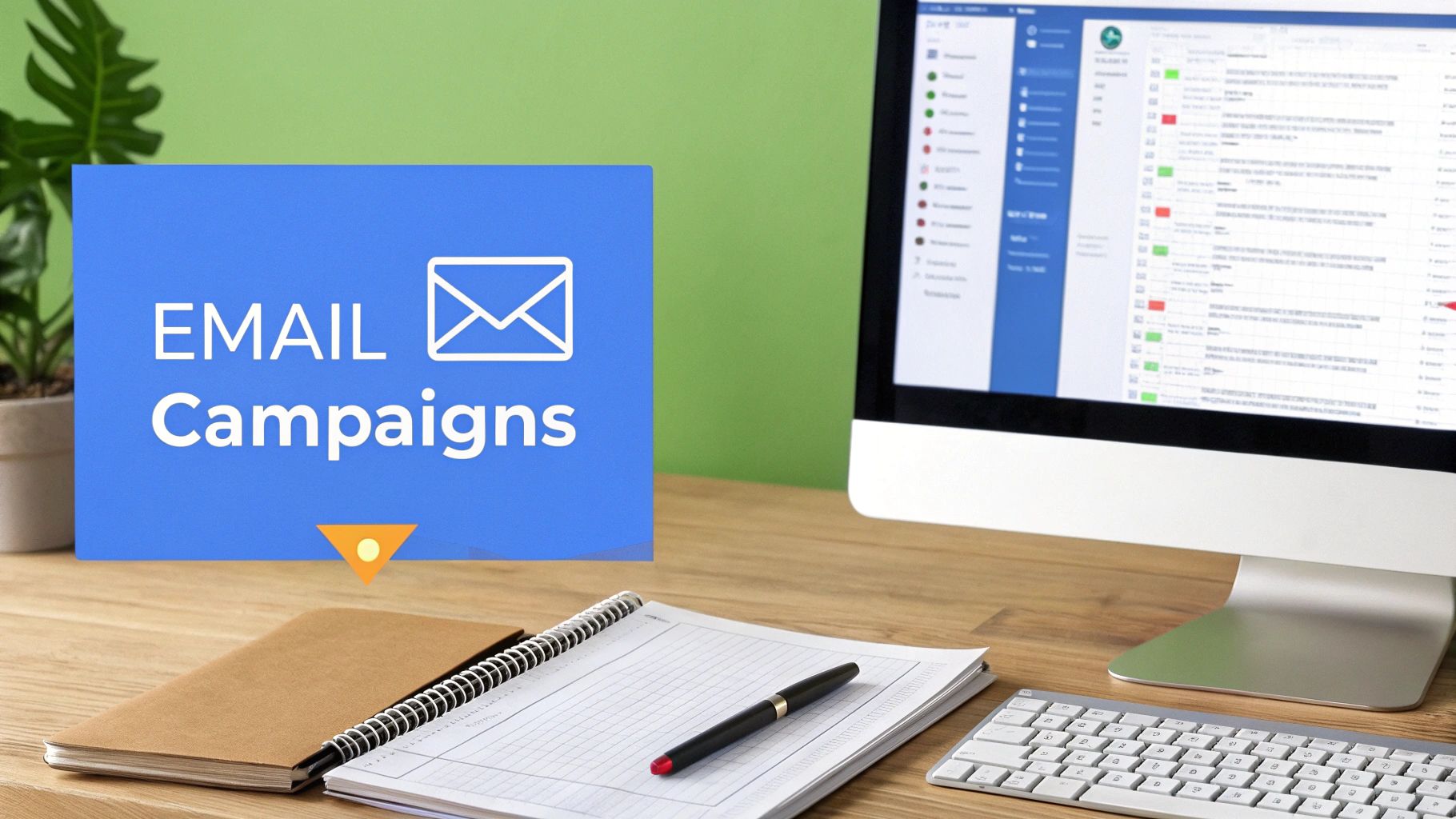
Strategic Breakdown: How Grammarly Converts Subscribers into Customers
Grammarly, the AI-powered writing assistant, excels at using email to drive conversions. Their strategy isn't just about promotional offers; it's about consistently demonstrating the value of their premium product through personalized, data-driven insights.
- Goal: Convert free users into paying subscribers by showcasing the benefits of Grammarly Premium.
- Tactic: Grammarly sends weekly "Writing Insights" emails. These emails summarize the user's activity, such as words written and common mistakes. Crucially, they also show "advanced issues" that Premium could have fixed.
- Value Proposition: The emails provide genuine value by gamifying the writing process. Simultaneously, they create a clear sense of missing out, compelling users to consider an upgrade.
- Outcome: This value-first approach effectively nurtures leads by reinforcing the product's utility. It builds a strong case for upgrading over time, leading to a highly successful freemium-to-premium conversion model.
Replicating the Strategy: Actionable Takeaways
To make email marketing a successful lead generation channel, you must move beyond generic newsletters. Are you ready to deliver personalized value?
- Segment Your Audience: Group subscribers based on their behavior or demographics. A new user needs a different message than a repeat visitor.
- Automate with Purpose: Create automated email sequences for different segments. An onboarding sequence, for example, can introduce your brand and highlight key benefits.
- Craft Compelling Copy and CTAs: Every email should have a single, clear objective. Use strong subject lines and a prominent call-to-action (CTA). Knowing how to measure the success of your marketing campaigns is crucial to refining your approach.
4. Search Engine Optimization (SEO) and Organic Traffic
Search Engine Optimization (SEO) is the practice of optimizing your website to rank higher in search results. Unlike paid advertising, this strategy attracts organic traffic from users actively seeking information. This makes it one of the most powerful lead gen examples for capturing high-intent prospects precisely when they are most engaged.
The core principle? Become the best answer to a potential customer's question. By creating authoritative content that aligns with search intent, you position your brand as a trusted resource. When someone finds your website on the first page of Google, they arrive as a highly qualified, pre-vetted lead.
Strategic Breakdown: How Zapier Captures Millions of Integration-Hungry Leads
Zapier, the automation platform, is a masterclass in SEO-driven lead generation. Their strategy hinges on a simple but brilliant insight: their customers are looking to connect specific apps. They have created a dedicated landing page for nearly every possible app integration, like "Connect Google Sheets to Slack."
- Goal: Capture long-tail search traffic from users looking to solve a specific integration problem.
- Tactic: Create thousands of highly-optimized landing pages targeting "[App A] + [App B] integrations" keywords. Each page details the benefits and provides a clear CTA.
- Landing Page: The pages are templated for scalability but customized with relevant logos and use cases. They are simple, direct, and laser-focused on converting a user with a specific need.
- Outcome: This scalable SEO strategy allows Zapier to rank for hundreds of thousands of long-tail keywords. It attracts millions of high-intent visitors each month, resulting in a massive and efficient lead generation engine.
Replicating the Strategy: Actionable Takeaways
To leverage SEO as a primary lead generation channel, think from your customer's perspective. What problems are they typing into Google?
- Focus on Commercial Intent Keywords: Target long-tail keywords that signal a user is close to a decision (e.g., "best project management software for small teams").
- Create Pillar Content and Topic Clusters: Develop a comprehensive "pillar" page on a broad topic and link out to more specific "cluster" articles. This builds authority and improves rankings.
- Prioritize Technical SEO: Ensure your website loads fast, is mobile-friendly, and has a clean structure. These factors are critical for ranking well and encouraging conversions.
5. Pay-Per-Click (PPC) Advertising
Pay-Per-Click (PPC) advertising is a model where advertisers pay a fee each time their ad is clicked. By targeting specific keywords and demographics on platforms like Google, businesses can drive immediate, high-intent traffic to their offers. This makes it one of the most direct and measurable lead gen examples available.
Unlike organic strategies that take time, PPC offers speed and precision. You can place your solution directly in front of prospects the moment they search for it. To understand the basics, you can learn more about how paid search advertising works.
Strategic Breakdown: How Salesforce Captures High-Value B2B Leads
Salesforce, the CRM giant, leverages Google Ads with surgical precision. A search for a high-intent keyword like "CRM software for small business" will almost always trigger a top-of-page ad from Salesforce, directing users to an optimized landing page.
- Goal: Capture qualified leads from businesses who are actively in the market for a CRM platform.
- Tactic: Bid on hyper-specific, long-tail keywords that indicate strong commercial intent (e.g., "best CRM for sales teams"). Each ad is paired with a dedicated landing page that mirrors the search query's intent.
- Landing Page: Salesforce’s landing pages are conversion masterpieces. They feature a clear headline, benefit-driven bullet points, social proof, and a prominent "Start My Free Trial" CTA.
- Outcome: This targeted PPC strategy allows Salesforce to consistently fill its sales pipeline with warm leads. It's a scalable, predictable engine for acquiring customers.
Replicating the Strategy: Actionable Takeaways
To effectively use PPC, you must focus on relevance from keyword to landing page. The entire user journey must be seamless.
- Start with High-Intent Keywords: Use exact and phrase match keywords to control costs and target users ready to act.
- Create Campaign-Specific Landing Pages: Never send PPC traffic to your homepage. Each ad group should have a dedicated landing page with a single, clear CTA.
- Aggressively Use Negative Keywords: Proactively build a list of negative keywords (e.g., "free," "jobs") to filter out irrelevant users and improve your ROI.
- Track Everything: Implement conversion tracking from day one. This data is essential for optimizing your ad spend and scaling what works.
6. Webinars and Virtual Events
Webinars and virtual events are powerful tools for engaging an audience in real-time. By offering expert insights on a specific topic, companies can attract a highly relevant audience and collect attendee information during registration. This makes it one of the most effective lead gen examples for generating qualified, sales-ready prospects.
The core of this strategy is the promise of exclusive knowledge. Unlike a blog post, a webinar offers interactivity through Q&A sessions and polls, fostering a deeper connection with potential customers. This direct engagement allows you to address specific questions and demonstrate your product's value.
Strategic Breakdown: How Salesforce Engages with Trailhead Virtual Events
Salesforce excels at using virtual events not just for lead generation but for community building through its Trailhead platform. Their events focus on career growth, technical skills, and industry trends, positioning Salesforce as an indispensable partner.
- Goal: Capture leads from professionals seeking to upskill, while nurturing a loyal community.
- Tactic: Offer free, high-value virtual events focused on career development and platform skills. Registration requires contact details, segmenting leads by interest.
- Landing Page: Each event has a dedicated page detailing the speakers, agenda, and learning outcomes. A clear CTA emphasizes the benefit of attending.
- Outcome: This approach generates a steady stream of highly engaged leads who are already invested in the Salesforce ecosystem.
Replicating the Strategy: Actionable Takeaways
To make this lead generation example work, treat your webinar as a premium educational product, not just a sales pitch. The value must outweigh the time commitment.
- Solve a Niche Problem: Choose a specific topic that addresses a critical pain point. "5 Ways to Triple E-commerce Sales in Q4" is more compelling than "An Introduction to E-commerce Marketing."
- Promote Extensively: Announce your event 2-3 weeks in advance across all channels. Send reminder emails to registrants to maximize attendance.
- Follow Up Strategically: Prepare separate follow-up email sequences for attendees and no-shows. Send the recording to everyone, but offer attendees an exclusive next step, like a demo.
The video below offers more insights into structuring a webinar that converts viewers into leads.
By prioritizing education over promotion, you can use webinars to build authority and fill your pipeline.
7. Referral Programs
Referral programs are a powerful method for generating leads by incentivizing existing customers to recommend your business. This approach leverages the most potent marketing tool: word-of-mouth trust. When a trusted friend recommends a product, the lead is often more qualified and converts at a higher rate, making this one of the most cost-effective lead gen examples.
The core concept is a mutually beneficial exchange. You reward loyal customers for spreading the word, and their referred friends receive an incentive to try your service. This creates a viral loop where every new customer can bring in another.
Strategic Breakdown: How Dropbox Became a Growth Case Study
Dropbox’s early growth is one of the most famous examples of referral marketing. Facing high customer acquisition costs, they implemented a simple, two-sided referral program integrated into the user onboarding experience.
- Goal: To acquire new users at a lower cost than paid ads by leveraging their existing user base.
- Tactic: Offer 500MB of extra storage space to both the referrer and the new person who signed up. The incentive was directly tied to the product’s core value.
- Landing Page/Process: The referral process was incredibly simple. Users could invite friends via email or a shareable link directly from their dashboard. The value proposition was clear: "Get more space."
- Outcome: The program was a phenomenal success. It permanently increased sign-ups by 60% and was responsible for 35% of all daily registrations, generating millions of new users.
Replicating the Strategy: Actionable Takeaways
How can you build a successful referral program? Remove friction and offer a compelling incentive.
- Offer a Two-Sided Incentive: Reward both the person referring and the person being referred. This increases the likelihood that your customer will share and their friend will sign up.
- Make Sharing Effortless: Integrate the referral option directly into your product or customer account portal. Provide a pre-written message and one-click sharing options.
- Promote the Program Actively: Don't just build it and hope they come. Promote your referral program through email, on your website, and after a positive customer experience.
Lead Generation Methods Comparison
From Examples to Execution: Your Next Steps
We've explored a gallery of powerful lead gen examples, from HubSpot's content strategy to Salesforce's targeted PPC campaigns. While the tactics vary, a few universal truths emerge from every successful case study. What did they all have in common?
The most effective strategies are never one-size-fits-all. They are born from a deep understanding of a specific audience's pain points. They succeed not by shouting the loudest, but by offering a clear, compelling value exchange.
Distilling the Core Principles of Winning Lead Gen
Reflecting on these diverse lead gen examples, we can identify a core framework that underpins their success. This is a strategic mindset you can apply to your own campaigns.
- Audience-Centricity is Non-Negotiable: Every winning campaign began with the customer. Your first step should always be to refine your ideal customer profile (ICP). What keeps them up at night?
- Value Must Precede the Ask: The "ask" for contact information is earned, not demanded. The perceived value of your offer must outweigh a user's hesitation to share their email.
- The Post-Click Experience is a Deal-Breaker: A brilliant ad is only half the battle. The journey from click to conversion hinges on the landing page. A slow or confusing page will sabotage your plans.
- Omnichannel Integration Creates Synergy: The most sophisticated lead gen examples don't operate in a vacuum. Each channel reinforces the others, creating a cohesive and powerful customer journey.
Turning Inspiration into Actionable Strategy
So, how do you translate these insights into tangible results? It’s time to build your own success story.
- Conduct a Channel Audit: Based on these examples, which channels are you underutilizing? Identify one new tactic to test in the next quarter.
- Map Your Value Proposition: Brainstorm three new lead magnet ideas tailored to different stages of the buyer's journey. Think beyond the standard eBook. Could you offer a checklist, a template, or a free tool?
- Optimize the Conversion Path: Critically evaluate your current landing pages. Are they personalized? Do they load quickly? Is the CTA clear? A/B testing can yield significant improvements.
- Measure What Matters: As you implement new strategies, tracking performance is paramount. Learning how to calculate Cost Per Acquisition (CPA) is essential for evaluating campaign efficiency and proving ROI.
Ultimately, the best lead generation strategies are dynamic and constantly evolving. Use these lead gen examples as your blueprint, but don't be afraid to innovate. Test, measure, and refine your approach relentlessly. The path to a scalable lead generation engine is paved with data-driven experimentation and a commitment to providing undeniable value.
The thread connecting all these lead gen examples is a seamless and persuasive post-click experience. LanderMagic empowers you to create dynamically personalized, lightning-fast landing pages that turn ad clicks into high-quality leads. Stop losing prospects on generic pages and start building conversion-focused experiences with LanderMagic.



